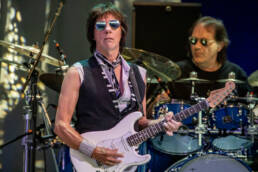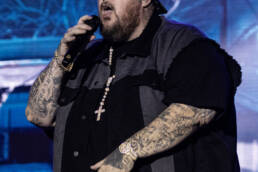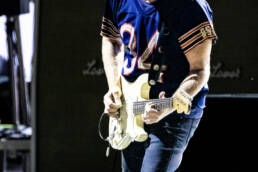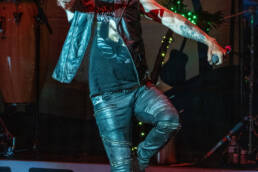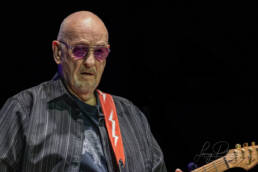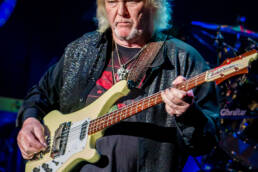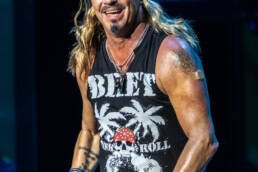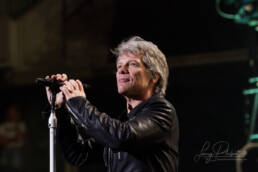Robert Smith of The Cure: Painting the World in Black and White
The Spark That Lit the Shadows
Imagine a rainy afternoon in Crawley, England, 1970s. A lanky 14-year-old Robert Smith sits in his bedroom, strumming a borrowed guitar, the drone of suburban life pressing against the windows. What pushed him toward music? It wasn’t a single lightning bolt but a slow burn—a need to escape the gray monotony of a working-class town and express the tangle of emotions he couldn’t voice. Raised on his older siblings’ records—Bowie, Hendrix, The Beatles—he found a lifeline in their strangeness. Suspension from school at 14 for being “too disruptive” (read: too weird) only sharpened his resolve. Music became his rebellion, his sanctuary, his way to scream without breaking the silence. As he later mused, “I wanted to make something that felt like my head sounded.”

From Crawley to the Cosmos
Born April 21, 1959, in Blackpool, England, Robert James Smith was the third of four kids in a family that bounced around before settling in Crawley, a postwar new town south of London. His dad, Alex, worked in a factory; his mom, Rita, was a housewife who sang lullabies that stuck with him. A shy, sensitive kid, Smith excelled at school until his quirks—spiky hair, dark humor—clashed with authority. By 1976, he’d formed Easy Cure with schoolmates at St Wilfrid’s Catholic Comprehensive, a band born from boredom and a shared love of punk’s raw edge. Dropping “Easy” in 1978, The Cure emerged, with Smith’s voice—fragile yet fierce—carving a lane between punk’s snarl and something dreamier.
The Cure’s early years were a whirlwind. Their debut, Three Imaginary Boys (1979), was a jagged postcard from post-punk Britain, but it was Seventeen Seconds (1980) and Pornography (1982) that plunged them into gothic waters. Smith, now sporting his signature teased hair and smeared lipstick, became the reluctant poster boy for a generation draped in black. The ’80s saw The Cure morph—The Head on the Door (1985) and Kiss Me, Kiss Me, Kiss Me (1987) flirted with pop, while Disintegration (1989) crystallized their legacy as masters of melancholy. Through lineup shifts and personal storms, Smith’s vision held firm, steering the band into the ’90s with Wish (1992) and beyond.
He’s lived much of his life with Lol Tolhurst, his childhood friend and co-founder, whose drumming defined early Cure records until addiction woes led to his 1989 exit (they reconciled decades later). Smith married Mary Poole, his school sweetheart, in 1988—a quiet anchor amid the chaos. They’ve no kids, by choice, and live reclusively in Sussex.
Career tapestry and Tangled Ties
The Cure’s core classic lineup: Smith (vocals, guitar), Simon Gallup (bass), Porl Thompson (guitar), Boris Williams (drums), and Roger O’Donnell (keys). Gallup, joining in 1979, remains Smith’s musical soulmate, though their bond fractured briefly in 1982 after a drunken brawl. Thompson left and returned twice, Williams exited in 1994, and O’Donnell’s been off-and-on since ’87. Tolhurst’s early role can’t be overstated—his keys shaped Faith (1981)—but Jason Cooper’s drumming since 1995 steadied the ship. Today, it’s Smith, Gallup, Cooper, O’Donnell, and Reeves Gabrels (guitar).
Smith’s collaborations ripple through music. He sang with Siouxsie and the Banshees in 1983, dated Siouxsie Sioux briefly (pre-Mary), and guested on tracks for Billy Corgan and Blink-182. His voice graced The Crow soundtrack (1994) via “Burn,” and he popped up as himself in South Park’s 1998 “Mecha-Streisand” episode—battling Barbra Streisand with goth flair. Awards? The Cure snagged a 2009 NME Godlike Genius nod, a 2019 Rock & Roll Hall of Fame induction, and Smith’s got a shelf of Ivor Novellos for songwriting.
The Cure’s biggest songs, all penned by Smith (often with band input):
- “Boys Don’t Cry” (Boys Don’t Cry, 1980) – A jangly cry of heartbreak, it hit #22 in the UK years after its debut, defining their early sound.
- “Just Like Heaven” (Kiss Me, Kiss Me, Kiss Me, 1987) – Smith’s love letter to Mary, this #40 US hit is pure dream-pop bliss.
- “Friday I’m in Love” (Wish, 1992) – A rare upbeat gem, peaking at #18 US, it’s Smith at his most playful.
- “Lovesong” (Disintegration, 1989) – Written for Mary, this #2 US hit weds gloom to tenderness.
Shadows of Scandal
Smith’s controversies are less tabloid splash and more slow-burn intrigue. In 1982, a fistfight with Gallup during the Pornography tour saw Gallup quit—Smith called it “the end,” but they patched up by ’84. Tolhurst’s 1989 ousting was messier; he sued Smith in 1994 over royalties, claiming co-ownership of The Cure’s name. The courts sided with Smith, but the rift stung fans. In 2018, Tolhurst’s memoir Cured rehashed old wounds—Smith shrugged it off, saying, “It’s his story.” Offstage, Smith’s battled depression and substance use, admitting in a 1989 NME interview to “dabbling in everything” during Pornography’s bleak sessions. His reclusive nature fuels rumors—veganism, tax evasion—but he’s dodged major scandal, letting the music speak.
The Endless Dream
From a Crawley misfit to a gothic laureate, Robert Smith turned alienation into art. The Cure’s 2024 album, Songs of a Lost World, their first in 16 years, proves his muse still haunts. At 65, he’s a living paradox—timeless yet frozen in 1989’s eyeliner haze. His story’s not over, but it’s already a cathedral of sound, built on a boy’s need to be heard.
